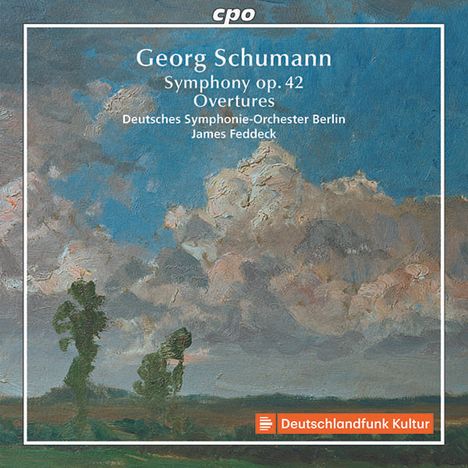Georg Schumann: Symphonie f-moll op. 42 auf CD
Symphonie f-moll op. 42
Herkömmliche CD, die mit allen CD-Playern und Computerlaufwerken, aber auch mit den meisten SACD- oder Multiplayern abspielbar ist.
+Ouvertüre zu einem Drama op. 45; Lebensfreude-Ouvertüre op. 54
- Künstler:
- Deutsches Symphonie-Orchester Berlin, James Feddeck
- Label:
- CPO
- Aufnahmejahr ca.:
- 2016
- Artikelnummer:
- 6096070
- UPC/EAN:
- 0761203511020
- Erscheinungstermin:
- 21.8.2017
Neues und Monumentales von Georg Schumann
Mit seiner Kammermusik, seinen Liedern sowie mit seiner ersten, der Preis-Symphonie, haben wir Sie schon bekannt gemacht. Eine sehr positive Kritik schrieb nach dem Erscheinen, dass sie neugierig auf weitere Entdeckungen mache. Voilà: Die zweite CD mit sinfonischen Werken von Georg Schumann, dem langjährigen Direktor der Sing-Akademie in Berlin und Kompositionsprofessor an der Preußischen Akademie der Künste. Heute entdeckt man ihn als Spätromantiker, während er zu Lebzeiten als Neuromantiker galt. Seine Symphonie in f-Moll ist Georg Schumanns monumentalstes Instrumentalwerk. Es ist ein Signum kleinerer Komponisten, dass sie die klassische, viersätzige Symphonieform mechanisch übernehmen. Nicht so Georg Schumann. Er lässt den 3. und 4. Satz, Scherzo und Finale, unmittelbar ineinander übergehen, wendet auch das traditionell Heitere und Spritzige des Scherzos ins Düstere. Und vor allem gilt, was schon ein Kritiker der Jugendsymphonie bemerkte: „wie sich ein Gedanke aus dem anderen logisch entwickelt“. Kombiniert wird die Symphonie mit zwei seiner Ouvertüren. Georg Schumann vermochte alle Stimmungen in der Musik auszudrücken – das macht seine Größe aus. Nach dem schwergewichtigen „Vorspiel zu einem Drama“ vermag er eine von Musizierlust überschäumende Ouvertüre „Lebensfreude“ zu schreiben.
Product Information
New Monumental Music by Georg Schumann
Georg Schumann is known to the cpo listening audience from our releases of his chamber music, songs, and first symphony, the »Praise Symphony.« One critic wrote in a very positive review of the symphony that it had made him eager for further discoveries. And so now here it is: our second CD with symphonic works by Georg Schumann, who was the director of the Sing-Akademie in Berlin for many years and a professor of composition at the Prussian Academy of the Arts. He is currently being rediscovered as a late romanticist, but during his lifetime he was regarded as a neoromanticist. The Symphony in F minor is his most monumental instrumental work. Minor composers typically adhere rather mechanically to the classical, four-movement symphonic form. But this does not at all apply to Georg Schumann! He has the scherzo third movement go over into the fourth and last movement without a break while taking the traditional mirth and sparkle of the scherzo into a gloomier sphere. And what one critic wrote of the symphony of his youth also is above all true here: »… how one idea logically develops from the other.« The recording also includes two of Georg Schumann’s overtures. He was able to express all the moods in music – and this is his claim to greatness. After the weighty »Prelude to a Drama« he wrote a joyous celebration of life in the »Lebensfreude« overture, a work overflowing with delight in musical performance.
Rezensionen
Pizzicato 10/2017: »Die Symphonie ›riecht‹ nach Brahms, ist aber in der Anlage insgesamt monumentaler als die Musik von Brahms. Auch Anklänge an die Musik von Wagner kann man ausmachen, vor allem im langen, grandiosen Adagio, für den der amerikanische Dirigent James Feddeck viel Atem einbringt, um die Steigerungen wirkungsvoll werden zu lassen.«MusicWeb International: "Dies sind wundervolle Werke und ich bin begeistert, sie kennengelernt zu haben."
Disk 1 von 1 (CD)
Sinfonie f-moll op. 42
-
1 1. Allegro moderato, molto energico
-
2 2. Adagio con moto
-
3 3. Allegro assai con molto passione
-
4 4. Finale: Allegro molto maestoso
-
5 Ouvertüre zu einem Drama op. 45
-
6 Ouvertüre "Lebensfreude" op. 54
Mehr von Georg Schumann












